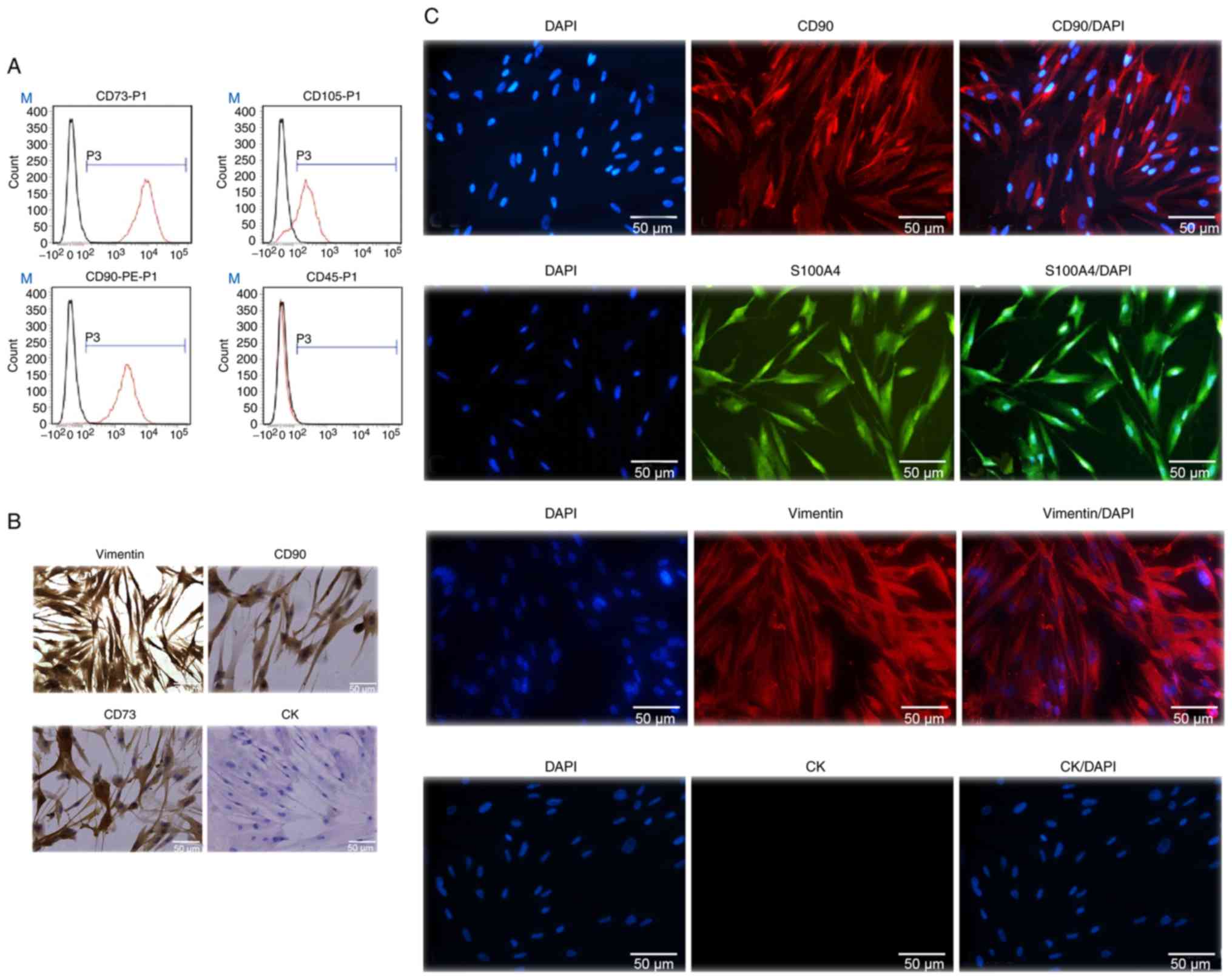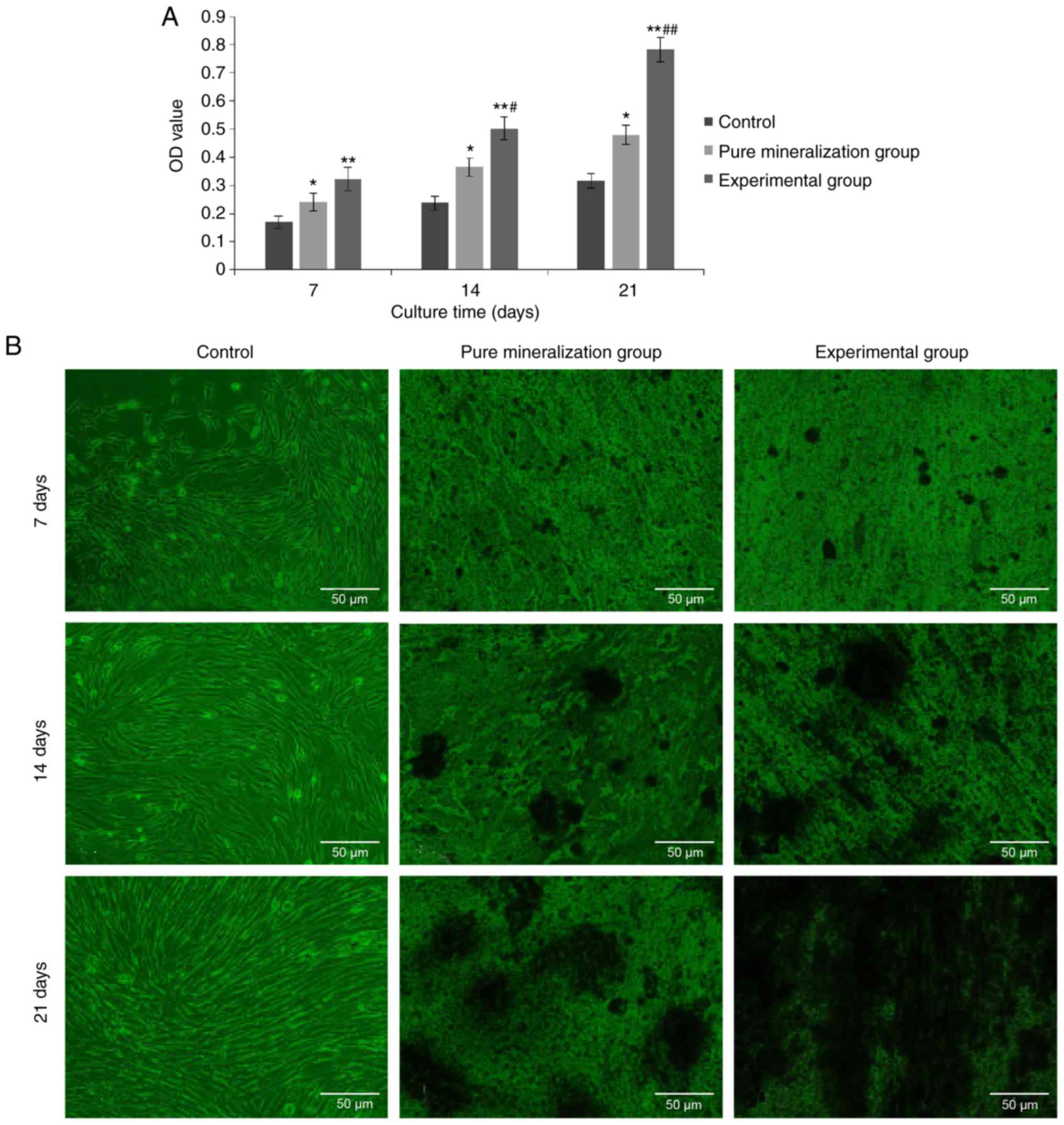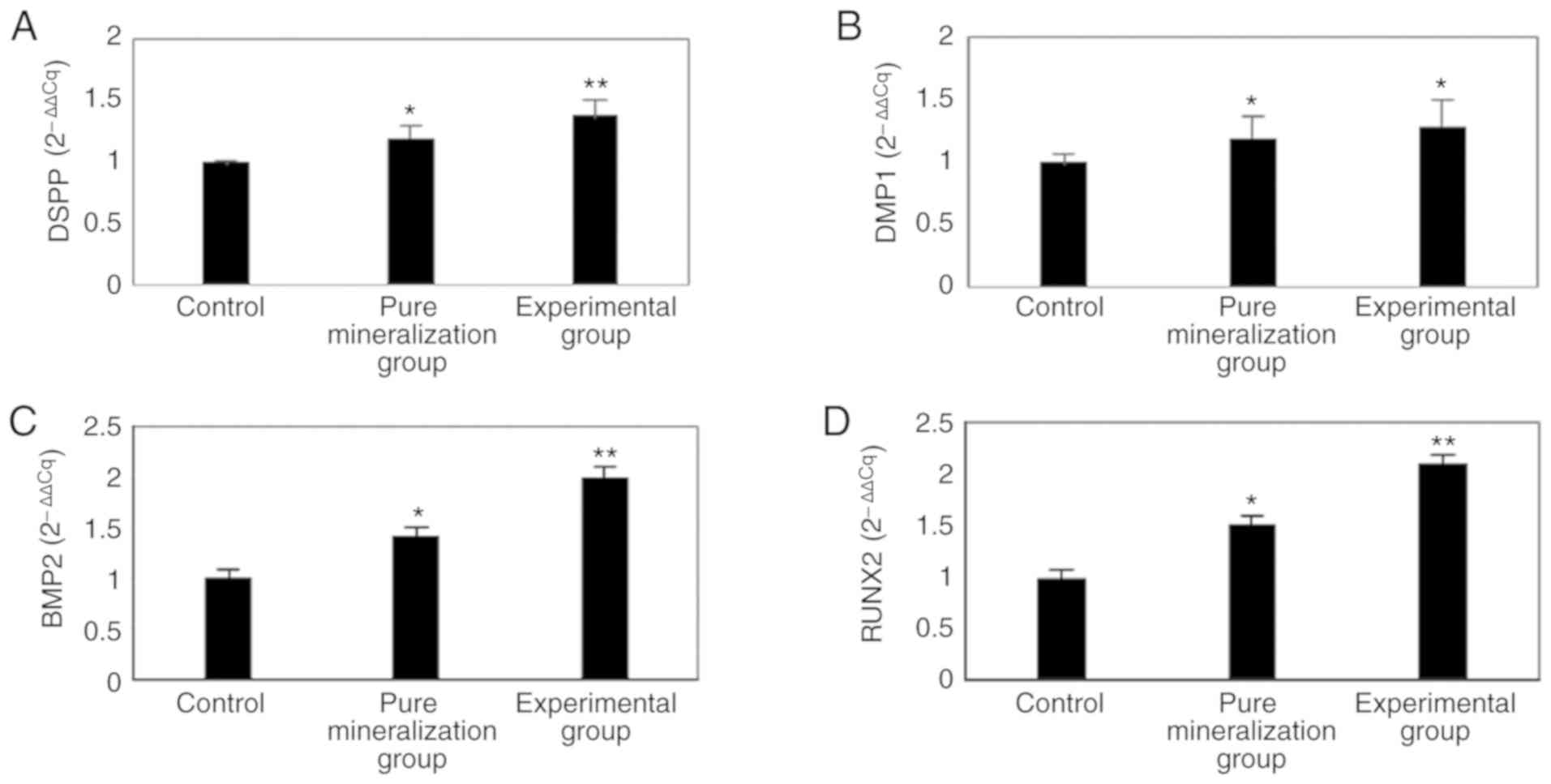|
1
|
Xu S, De Veirman K, De Becker A,
Vanderkerken K and Van Riet I: Mesenchymal stem cells in multiple
myeloma: A thera-peutical tool or target? Leukemia. 32:1500–1514.
2018. View Article : Google Scholar : PubMed/NCBI
|
|
2
|
Dominici M, Le Blanc K, Mueller I,
Slaper-Cortenbach I, Marini F, Krause D, Deans R, Keating A,
Prockop D and Horwitz E: Minimal criteria for defining multipotent
mesenchymal stromal cells. The International Society for Cellular
Therapy position statement. Cytotherapy. 8:315–317. 2006.
View Article : Google Scholar : PubMed/NCBI
|
|
3
|
Stenderup K, Justesen J, Clausen C and
Kassem M: Aging is associated with decreased maximal life span and
accelerated senescence of bone marrow stromal cells. Bone.
33:919–926. 2003. View Article : Google Scholar : PubMed/NCBI
|
|
4
|
Tomar GB, Srivastava RK, Gupta N,
Barhanpurkar AP, Pote ST, Jhaveri HM, Mishra GC and Wani MR: Human
gingiva-derived mesenchymal stem cells are superior to bone
marrow-derived mesenchymal stem cells for cell therapy in
regenerative medicine. Biochem Biophys Res Commun. 393:377–383.
2010. View Article : Google Scholar : PubMed/NCBI
|
|
5
|
Mitrano TI, Grob MS, Carrión F,
Nova-Lamperti E, Luz PA, Fierro FS, Quintero A, Chaparro A and Sanz
A: Culture and characterization of mesenchymal stem cells from
human gingival tissue. J Periodontol. 81:917–925. 2010. View Article : Google Scholar : PubMed/NCBI
|
|
6
|
Zhang Q, Shi S, Liu Y, Uyanne J, Shi Y,
Shi S and Le AD: Mesenchymal stem cells derived from human gingiva
are capable of immunomodulatory functions and ameliorate
inflammation-related tissue destruction in experimental colitis. J
Immunol. 183:7787–7798. 2009. View Article : Google Scholar : PubMed/NCBI
|
|
7
|
Kim TH, Kim SH, Sándor GK and Kim YD:
Comparison of platelet-rich plasma (PRP), platelet-rich fibrin
(PRF), and concentrated growth factor (CGF) in rabbit-skull defect
healing. Arch Oral Biol. 59:550–558. 2014. View Article : Google Scholar : PubMed/NCBI
|
|
8
|
Qiao J and An N: Effect of concentrated
growth factors on function and Wnt3a expression of human
periodontal ligament cells in vitro. Platelets. 28:281–286. 2017.
View Article : Google Scholar
|
|
9
|
Rodella LF, Favero G, Boninsegna R,
Buffoli B, Labanca M, Scari G, Sacco L, Batani T and Rezzani R:
Growth factors, CD 34 p ositive cells, and fibrin network analysis
in concentrated growth factors fraction. Microsc Res Tech.
74:772–777. 2011. View Article : Google Scholar : PubMed/NCBI
|
|
10
|
Tayapongsak P, O'Brien DA, Monteiro CB and
Arceo-Diaz LY: Autologous fibrin adhesive in mandibular
reconstruction with particulate cancellous bone and marrow. J Oral
Maxillofac Surg. 52:161–165; discussion 166. 1994. View Article : Google Scholar : PubMed/NCBI
|
|
11
|
Bozkurt Doğan Ş, Öngöz Dede F, Ballı U,
Atalay EN and Durmuşlar MC: Concentrated growth factor in the
treatment of adjacent multiple gingival recessions: A split-mouth
randomized clinical trial. J Clin Periodontol. 42:868–875. 2015.
View Article : Google Scholar
|
|
12
|
Takeda Y, Katsutoshi K, Matsuzaka K and
Inoue T: The effect of concentrated growth factor on rat bone
marrow cells in vitro and on calvarial bone healing in vivo. Int J
Oral Maxillofac Implants. 30:1187–1196. 2015. View Article : Google Scholar : PubMed/NCBI
|
|
13
|
Mosmann T: Rapid colorimetric assay for
cellular growth and survival: Application to proliferation and
cytotoxicity assays. J Immunol Methods. 65:55–63. 1983. View Article : Google Scholar : PubMed/NCBI
|
|
14
|
Livak KJ and Schmittgen TD: Analysis of
relative gene expression data using real-time quantitative PCR and
the 2(-Delta Delta C(T)) method. Methods. 25:402–408. 2001.
View Article : Google Scholar
|
|
15
|
Heng BC, Zhang C, Deng X, Xiao Y,
Pisciotta A, Kidwai F and Mitsiadis TA: Biomedical applications of
dental and oral-derived stem cells. Stem Cells Int.
2017:29310542017. View Article : Google Scholar : PubMed/NCBI
|
|
16
|
Ji J, Tong X, Huang X, Zhang J, Qin H and
Hu Q: Patient-derived human induced pluripotent stem cells from
gingival fibroblasts composited with defined
nanohydroxyapatite/chitosan/gelatin porous scaffolds as potential
bone graft substitutes. Stem Cells Transl Med. 5:95–105. 2016.
View Article : Google Scholar :
|
|
17
|
Fawzy El-Sayed KM and Dörfer CE: Gingival
mesenchymal stem/progenitor cells: A unique tissue engineering gem.
Stem Cells Int. 2016:71543272016. View Article : Google Scholar : PubMed/NCBI
|
|
18
|
Liu X, Wang J, Dong F, Li H and Hou Y:
Human gingival fibroblasts induced and differentiated into vascular
endothelial-like cells. Dev Growth Differ. 58:702–713. 2016.
View Article : Google Scholar : PubMed/NCBI
|
|
19
|
Liu X, Wang J, Dong F, Li H and Hou Y:
Induced differentiation of human gingival fibroblasts into
VSMC-like cells. Differentiation. 95:1–9. 2017. View Article : Google Scholar : PubMed/NCBI
|
|
20
|
Xu X, Chen C, Akiyama K, Chai Y, Le AD,
Wang Z and Shi S: Gingivae contain neural-crest- and
mesoderm-derived mesenchymal stem cells. J Dent Res. 92:825–832.
2013. View Article : Google Scholar : PubMed/NCBI
|
|
21
|
Ansari S, Diniz IM, Chen C, Sarrion P,
Tamayol A, Wu BM and Moshaverinia A: Human periodontal ligament-
and gingiva-derived mesenchymal stem cells promote nerve
regeneration when encapsulated in alginate/Hyaluronic acid 3D
scaffold. Adv Healthc Mater. 6:2017.PubMed/NCBI
|
|
22
|
Bernardi S, Mummolo S, Tecco S, Continenza
MA and Marzo G: Histological characterization of Sacco's
concentrated growth factors membrane. Int J Morphol. 35:114–119.
2017. View Article : Google Scholar
|
|
23
|
Qin J, Wang L, Sun Y, Sun X, Wen C,
Shahmoradi M and Zhou Y: Concentrated growth factor increases
Schwann cell proliferation and neurotrophic factor secretion and
promotes functional nerve recovery in vivo. Int J Mol Med.
37:493–500. 2016. View Article : Google Scholar
|
|
24
|
Kim JM, Sohn DS, Bae MS, Moon JW, Lee JH
and Park IS: Flapless transcrestal sinus augmentation using
hydrodynamic piezoelectric internal sinus elevation with autologous
concentrated growth factors alone. Implant Dent. 23:168–174. 2014.
View Article : Google Scholar : PubMed/NCBI
|
|
25
|
Sohn DS, Heo JU, Kwak DH, Kim DE, Kim JM,
Moon JW, Lee JH and Park IS: Bone regeneration in the maxillary
sinus using an autologous fibrin-rich block with concentrated
growth factors alone. Implant Dent. 20:389–395. 2011.PubMed/NCBI
|
|
26
|
Liu Y, Kalén A, Risto O and Wahlström O:
Fibroblast proliferation due to exposure to a platelet concentrate
in vitro is pH dependent. Wound Repair Regen. 10:336–340. 2002.
View Article : Google Scholar : PubMed/NCBI
|
|
27
|
Mornet E, Stura E, Lia-Baldini AS,
Stigbrand T, Ménez A and Le Du MH: Structural evidence for a
functional role of human tissue nonspecific alkaline phosphatase in
bone mineralization. J Biol Chem. 276:31171–31178. 2001. View Article : Google Scholar : PubMed/NCBI
|
|
28
|
Douglas TE, Messersmith PB, Chasan S,
Mikos AG, de Mulder EL, Dickson G, Schaubroeck D, Balcaen L,
Vanhaecke F, Dubruel P, et al: Enzymatic mineralization of
hydrogels for bone tissue engineering by incorporation of alkaline
phosphatase. Macromol Biosci. 12:1077–1089. 2012. View Article : Google Scholar : PubMed/NCBI
|
|
29
|
Choi YS, Lee JY, Suh JS, Lee G, Chung CP
and Park YJ: The mineralization inducing peptide derived from
dentin sialophosphoprotein for bone regeneration. J Biomed Mater
Res A. 101:590–598. 2013. View Article : Google Scholar
|
|
30
|
Gericke A, Qin C, Sun Y, Redfern R,
Redfern D, Fujimoto Y, Taleb H, Butler WT and Boskey AL: Different
forms of DMP 1 p lay distinct roles in mineralization. J Dent Res.
89:355–359. 2010. View Article : Google Scholar : PubMed/NCBI
|
|
31
|
Bhatia A, Albazzaz M, Espinoza Orias AA,
Inoue N, Miller LM, Acerbo A, George A and Sumner DR:
Overexpression of DMP1 accelerates mineralization and alters
cortical bone biomechanical properties in vivo. J Mech Behav Biomed
Mater. 5:1–8. 2012. View Article : Google Scholar
|
|
32
|
Narayanan K, Srinivas R, Ramachandran A,
Hao J, Quinn B and George A: Differentiation of embryonic
mesenchymal cells to odontoblast-like cells by overexpression of
dentin matrix protein 1. Proc Natl Acad Sci USA. 98:4516–4521.
2001. View Article : Google Scholar : PubMed/NCBI
|
|
33
|
Monteiro N, Ribeiro D, Martins A, Faria S,
Fonseca NA, Moreira JN, Reis RL and Neves NM: Instructive
nanofibrous scaffold comprising runt-related transcription factor 2
gene delivery for bone tissue engineering. ACS Nano. 8:8082–8094.
2014. View Article : Google Scholar : PubMed/NCBI
|
|
34
|
Li S, Kong H, Yao N, Yu Q, Wang P, Lin Y,
Wang J, Kuang R, Zhao X, Xu J, et al: The role of runt-related
transcription factor 2 (Runx2) in the late stage of odontoblast
differentiation and dentin formation. Biochem Biophys Res Commun.
410:698–704. 2011. View Article : Google Scholar : PubMed/NCBI
|
|
35
|
Zhang C, Meng C, Guan D and Ma F: BMP2 and
VEGF165 transfection to bone marrow stromal stem cells regulate
osteogenic potential in vitro. Medicine (Baltimore). 97:e97872018.
View Article : Google Scholar
|
|
36
|
Qin W, Yang F, Deng R, Li D, Song Z, Tian
Y, Wang R, Ling J and Lin Z: Smad 1/5 is involved in bone
morphogenetic protein-2-induced odontoblastic differentiation in
human dental pulp cells. J Endod. 38:66–71. 2012. View Article : Google Scholar
|
















